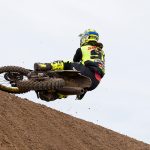As the last FIM World Championship series with two races on the same day, MXGP forces a demanding timetable on athletes and the way each competitor deals with that important gap between the first and second outings can have important physical and mental repercussions. We asked a small clutch of riders young and old how they approach the crucial moments and minutes that separate the motos…
Roughly two hours and twenty minutes between rolling into the paddock and the gate dropping for the second thirty minute and two lap race: this is the amount of time MX2 and MXGP athletes have to recover, re-evaluate and prepare to go full tilt for another dash.
It is often a nervy time for Grand Prix riders and where the events of the opening sprint of a meeting can very much determine what goes on as the mind switches instantly to the second challenge. Some will have strict routines, others will frantically react to any physical problems or issues of performance, many will receive input and feedback from their closest circles and almost all will be addressing the physiological need to repair the ‘damage’ and ‘wear’ from the thirty-five minutes of often brutal punishment, especially in sand.
So, what do they do and why? We sought answers…
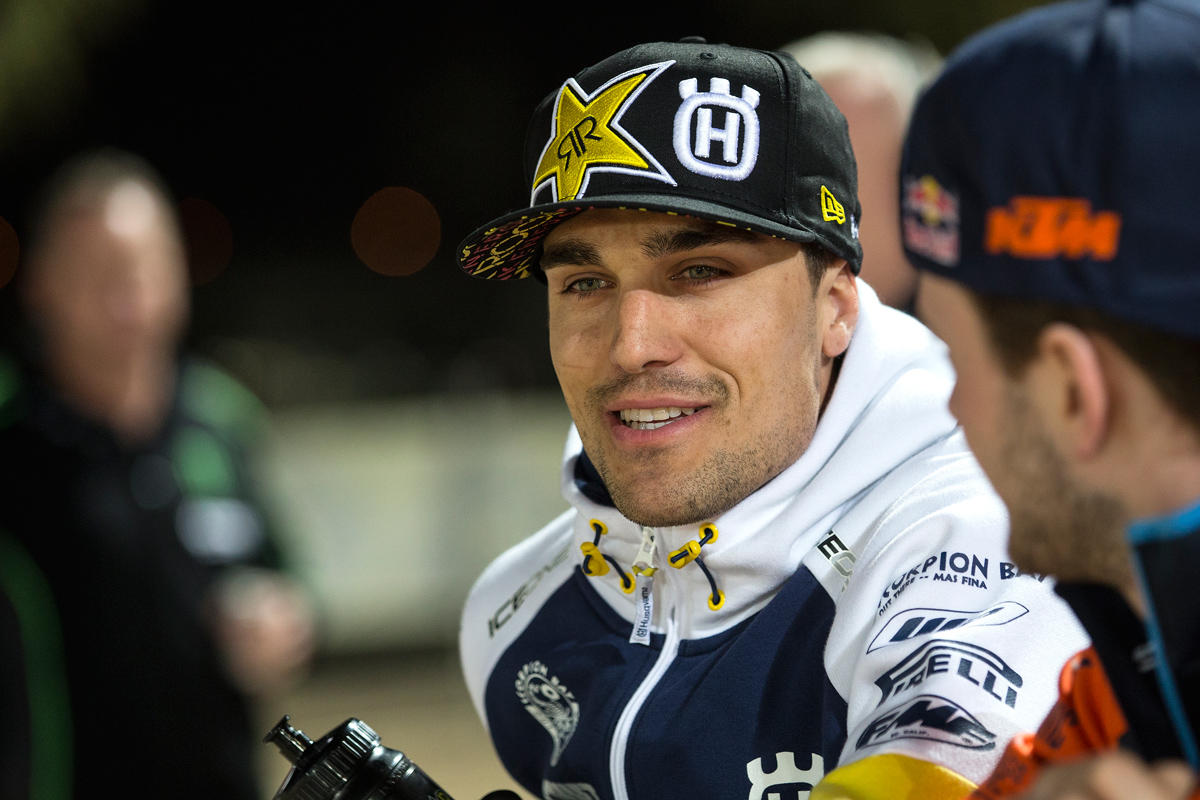
Gautier Paulin, Rockstar Energy IceOne Husqvarna, MXGP: “If I am fit then I don’t need people to take care of me: I don’t need a massage or any other attention. I drink a lot of water and I eat, but not too much because I don’t want something – or the feeling – that is heavy to digest. When it is a ‘heavy’ race then I might cycle for a bit also. I will have a meeting with the team and then rest. I can sleep.”
Vsevolod Brylyakov, Monster Energy DRT Kawasaki, MX2: “I try to get some food! And do some recovery cycling after the moto to move my muscles a little bit and get my heart rate down. I’ll eat a little pasta or rice and a cereal or energy bar; it is all about quick carbohydrates and calories. I’ll relax and watch the MXGP moto because all my stuff is already prepared before warm-up in the morning. I will also think where I can be better and where I was making mistakes, also where I was doing well.”
Shaun Simpson, Wilvo Yamaha, MXGP: “When you have done as many Grands Prix as I have then you tend to try a lot of different scenarios! In the early years I used to stress a lot about getting out to look at lines on the track or rushing to see the other class and I didn’t take enough time to look at my race, where I had gone wrong or right, refuelled, rehydrated and rested! I was in too much of a hurry. Now I just like to be organised. I have my stuff ready, Rachel will have some food ready and I’ll have a mat in the camper or team truck where I can rest or stretch.”
Glenn Coldenhoff, Red Bull KTM, MXGP: “The process is nearly always the same: debrief with the team, talk about improvements and then get changed, have something to eat in the Red Bull hospitality and get ready to go again. It passes by pretty quickly actually.”
Pauls Jonass, Red Bull KTM, MX2: “It is about quick recovery, so a bit of spinning for the lactic acid and a bit of food for more energy. By then there is usually an hour left so time to check the goggles and then get dressed for the second moto.”
Kevin Strijbos, Team Suzuki, MXGP: “There was a time when I cycled and then watched the other race and then a few years where I slept after a little cycle and a shower. Now I’m still on the cycle if I feel good.”
Exercise, eating & rest
Stephan Nuesser, Sport Scientist: “Nowadays you see many riders on exercise bikes after the races and that’s mostly to burn off lactate; you have a quicker burn rate if you do exercise and it stimulates general blood flow for quicker oxygen supply and recuperation to tissues and muscles. A small activation period is better than doing nothing.”
Coldenhoff: “Normally Pauls always has a bicycle on hand and I’ll use it sometimes when I feel that a race has been quite heavy on my legs.”
Nuesser: “If you look at the Tour de France then the Prologue is 8-10kms which takes fifteen minutes and they will be doing a thirty-forty minute warm-up. After that they will also do a proper cool-down. Those motocross riders who have a sandwich and sit in their chair are not on the level they could be.”
Simpson: “Refuelling is a massive part that people underestimate or don’t look at enough. You need to make sure you have the right amount of food at the right time; so you’re not eating too late and your body is trying to digest when you are sitting on the line for race two.”
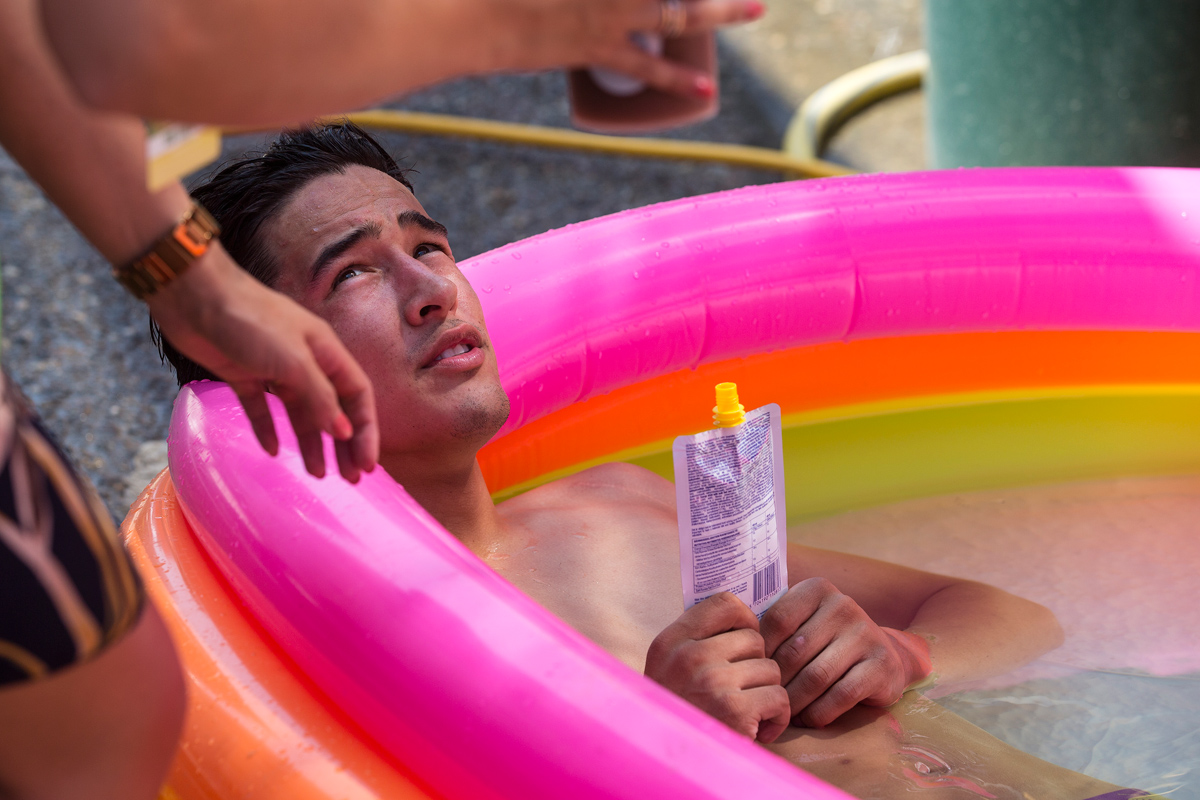
Coldenhoff: I’m in an Italian team! So you can guess what I eat! We can order what we like at Red Bull so some days it is rice and chicken or usually pasta with pesto; I eat that most race weekends.”
Nuesser: “There is a limited storage of carbohydrates in the liver and the muscles and in the first race you lose quite a bit of that energy. As an estimation: say you have a storage of 1800 calories of carbs then I’d presume you’d lose around 1000, so half the storage – yes, you have fatty acids but we’ll leave those aside for the moment – therefore it is an important thing to have a quick and efficient refuel of that lost energy which makes special products important because you only have a limited absorption capacity from the gut and the stomach, around 80grams of carbs per hour. You need to make sure you have enough and easily accessible carbs.”
Simpson: “I try to keep it really simple. I fuel-up before the GP on a Thursday and Friday and on Saturday a good breakfast at least two hours before going out on the track, and then just top that up with a mix of carbs and proteins, cereal bars and bananas and then I’ll have a rice, chicken and vegetable dish in the middle of the days at a specific time: that has proven to work for me and my digestive system. Even things like needing to go to the toilet, you can tell a lot from silly small things but by repeating them over and over. If you are stocked up before the race then you don’t have to eat loads on race day. Even drinking water and electrolytes that all starts on a Thursday and you just top-up. It is nearly all second-nature to me and what you can do in order to be in your best shape for a GP. It doesn’t always equate to a great result as we already know! What I say might not work for everyone but the key points will be similar of recovery and refuelling at the right time with the right food.”
Nuesser: “Hydrations is a tricky subject. You have these recommendations that per-hour of exercise you should drink 4-600ml of fluid. If you would apply that for marathon runners then it wouldn’t work. Average fluid consumption of the top marathon runners is 200ml. So there is the recommendation and then the practical data! I would say ‘drink when you’re thirsty’ although I do feel that many riders don’t drink enough or pay attention to this but it is very individual and depends on temperatures and humidity. Obviously through the gear and helmets there is higher demand and higher loss compared to say cyclists.”
Paulin: “The biggest stress for me on the day of a race is waking up and seeing how I feel. I hope I am not tight or tired. As a racer – and I don’t know why – it has always been my worry! It has never really happened because I am fit and it’s why I do long motos and train hard. You need to focus so much and really respect these motorcycles that I don’t want to be in a position where I can make a mistake. It is already very hard to be that fit. To let a result go because I am tired would be hard to accept. So, even if a first moto is hard I am rested and ready for the second. I have the same goal. Even on a Monday after somewhere after like Arco di Trento when the track is not really that difficult then I will be out on the bike on the Monday.”
Brylyakov: “You feel it a little bit but it’s exactly the same when you are training so you are familiar with it. I would say last year was worse because I didn’t have that many hours on the bike. This year I’ve been feeling fresh and after Arco di Trento I didn’t even feel like I’d done a race already.”
Nuesser: “The better your overall physical condition then the better your recovery.”
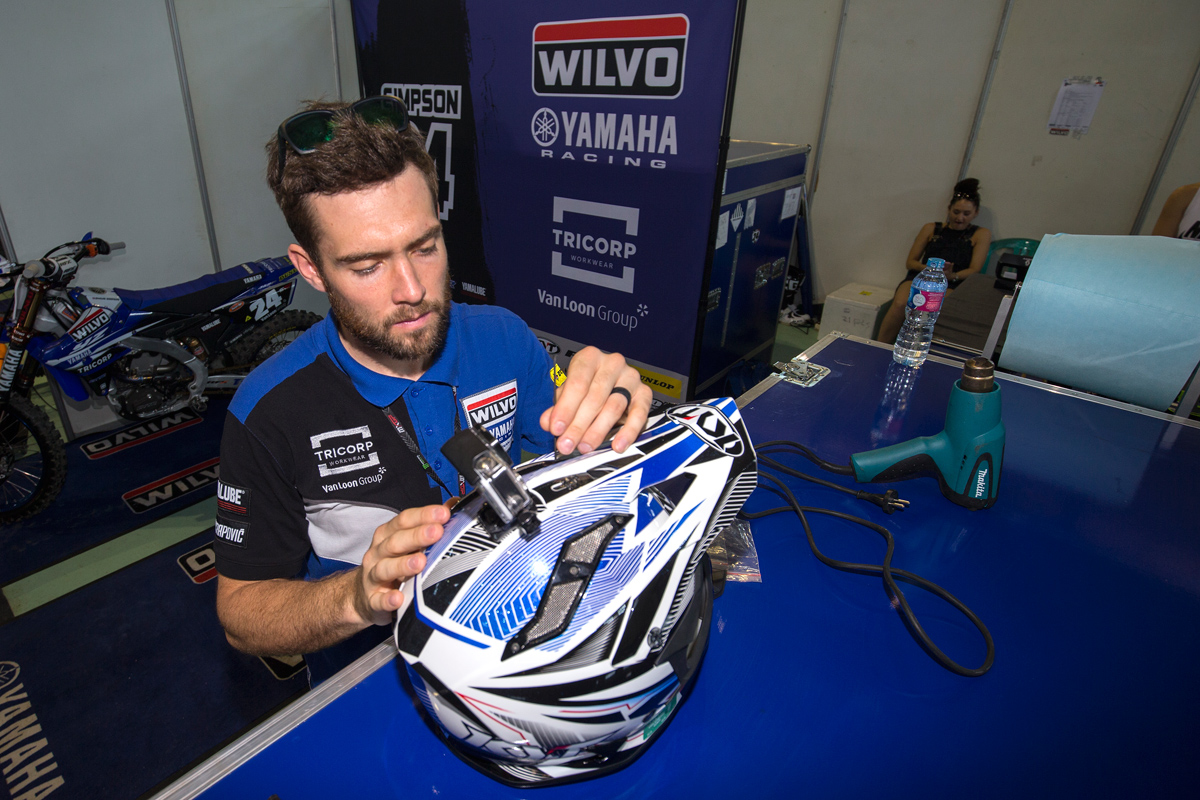
Simpson: “I think it is important to get your head down for about half an hour and just gather your thoughts and recover a little bit. I feel more revived and recharged after that. I’ve been playing around with the sleep-thing actually and try to squeeze in a half-hour nap most days. It gets to the point where your body almost expects it: that little re-charge moment. It is crazy how your body works. If someone had told me to do it years ago I would have thought ‘what are you talking about?’ and if you do it more than thirty minutes then it has been well proven that it can be detrimental. It is not easy sleeping in this kind of environment but the calmness of lying down, feeling your heartbeat slow and putting your feet up is beneficial and you might actually doze for five-ten minutes. You do feel recharged and it is quite a strange feeling. It is something I’ve only started in the last couple of years and you have to be quite strict with it otherwise it is not advantageous at all.”
Strijbos: “The body feels it and before the second moto you feel like you have less power. I think that is normal and everybody has that, at some races more than others and also about how the first moto goes: it could have been very easy or you fought all the way for a twelfth position.”
The process and the headspace
Jonass: “The feeling of time depends on the race you’ve just had, how the track is and things like the fans. Sometimes it feels very short and sometimes very long: such as the overseas events where you don’t have so much to do. In Europe we’ll have the Red Bull hospitality so you can relax there and watch some of the MXGP race.”
Brylyakov: “Time does go quickly simply because of the amount of things you want to do, as well as rest and then get ready twenty-five minutes before the start of the next moto.”
Coldenhoff: “The first moments afterwards you are always analysing. Joel [Smets] and Claudio [De Carli] come over and my mechanics and they always ask about the bike and any changes we need to make. I usually speak quite a lot with Joel and he makes some good video analysis and after the race we watch those images. There are always small things to improve.”
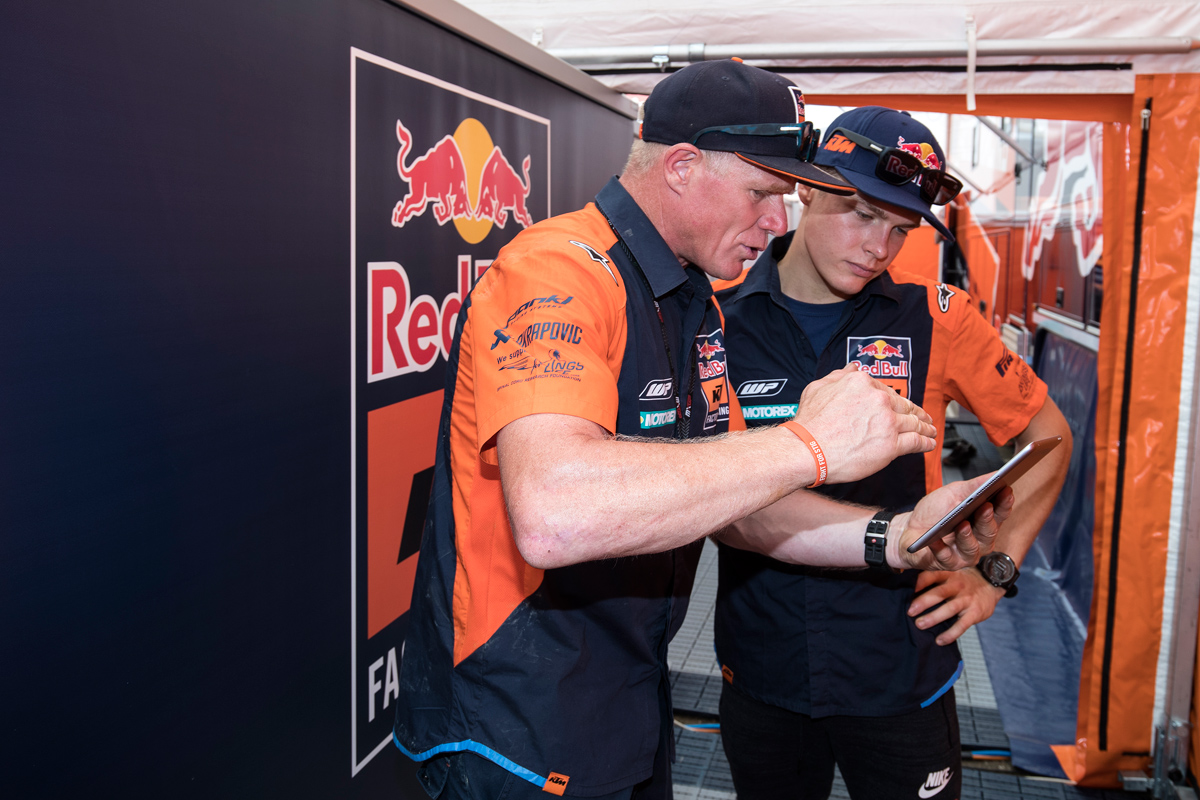
Jonass: “Now I have Marc [De Reuver] there and the team are always ready and willing to make any changes. Normally if things are going well then I’ll just think about what I could do better without having any meetings or more analysis.”
Paulin: “As a kid if I was pissed then it could affect my second moto because I was unhappy…now I know to accept and learn from the past and keep on moving. Walking to the gate I feel normal.”
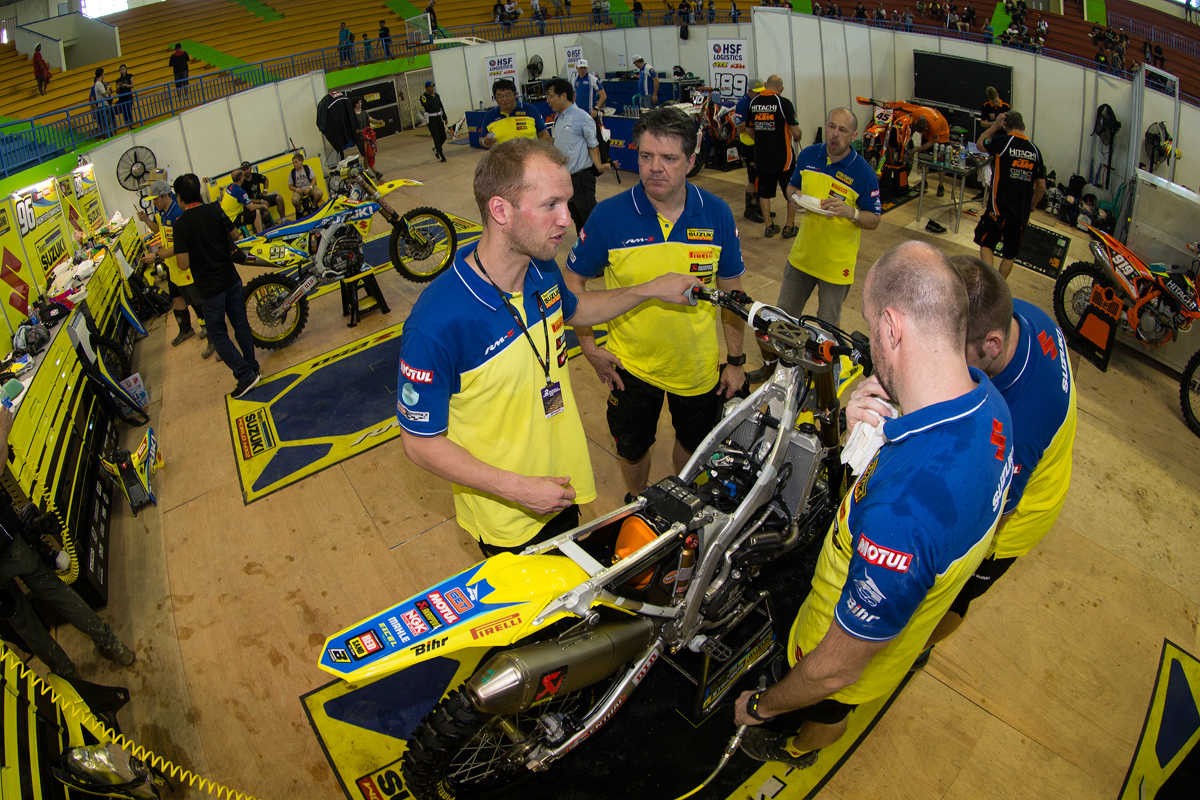
Strijbos: “It was difficult in the past to mentally move on from the first moto. I think it gets easier with age and especially when you have children. In the past I might have a DNF and throw the bike down, walk away and not talk to anyone. Now I am more likely to push the bike back, talk and analyse with the team and then going back to the camper you see the baby and it helps get rid of the stress. It is more frustration than anger. You still care a lot but you are more accepting and there is no need to react like a lunatic.”
Simpson: “It is different every week. If you have a textbook first moto then the second could be a case of dejavu: or that’s what you hope for. Or you feel knackered because you went down on the first corner and had to charge all the way through. Sometimes you feel good but are fired-up for something better. You have to seize all the circumstances. Importantly you need to absorb the good points from the first race and hold them while getting rid of the mistakes. Very rarely will it go the same – especially now in MXGP where one race you could start fifth and in another fifteenth – but there are a lot of routines every race and every week.”
Coldenhoff: “Sometimes you think ‘it’s going to be a tough one’. In Mexico I had a crash on Saturday and was in a lot of pain in the first moto. But then you also think ‘it’s only 35 minutes, just go for it’. In Arco I had a bad first moto but felt good physically and pulled myself together. I made a good start and had a good result. Just before that race I was telling myself to really push and was very motivated to make something happen.”
Simpson: “I try to keep light-hearted and loose because it stops me feeling uptight about the situation. I know that [Tim] Gajser and some of those guys like to be strongly focussed but that just makes me tired; instead of pumping me up it has the reverse effect. I actually start yawning when I get nervous, everyone has their own tick and gesture. People used to ask me ‘are you tired?’ but no, I was fired up! It was just my thing.”
Strijbos: “If you are struggling with the track, you are getting tired and the first moto doesn’t go well then it can get tiring mentally as well and you need to find a way ‘back’ for the second moto. You just need to get through it and do the best you can because sometimes there is no goal because the weekend hasn’t gone well…but then it can also turn around very quickly. You can be in the gate and the ‘click’ comes and the GP finishes well. The first race can also make you feel like everything is on rails. It is strange how it can change. The adrenaline is always there.”
Photos by Ray Archer


